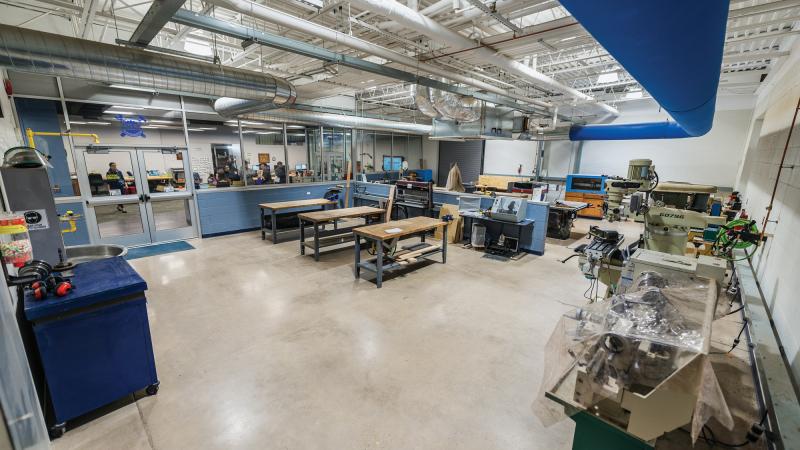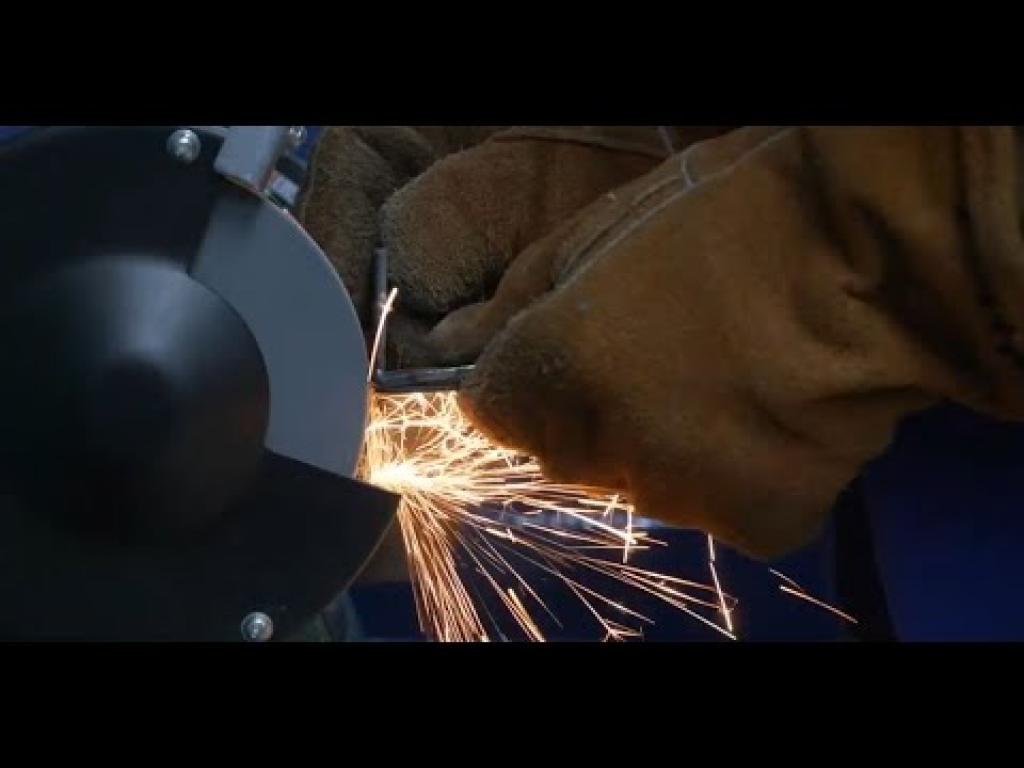In The Gilmour Tinkertorium, welding students pore over online images that can be readily rendered in vinyl to adorn their toolboxes.
Making Makers
Published 08.18.2020

by Tom Wilson
Writer/Editor-Penn College News
Black walnut and cherry, milled just over the mountain at Pennsylvania College of Technology’s Schneebeli Earth Science Center, cascade to the floor in ribbon curls as Mason Peters wields his favorite gouge on the turning lathe.
At a nearby computer numerical control router that he assembled, Anthony F. O’Koren watches as programmed letters are cut into a slab of wood, forming a fitting mantra for his surroundings: “Learn the unknown. Make the unseen. Teach the unspeakable.”
On the other side of the wall, Barbara J. LeGeyt delivers a mandatory safety lecture before teaching metal inert gas welding to a pair of fellow students.
It’s a beehive of activity on any given day at The Dr. Welch Workshop: A Makerspace at Penn College, student-designed and dedicated in August 2018 as an impetus to collegewide innovation and collaboration.
This particular afternoon includes a brewing and fermentation science student etching a club logo onto pint glasses for a fundraiser; an amateur fashion designer, stylishly clad in one of her own creations, pinning fabric to a dress form; and a group of students huddled over a butcher-block table, scouring the web for just the right images to replicate in vinyl.
The buzz is effectively managed by attendant Jeremiah C. Johnson and assistant Roberta Schwenk, whose combined counsel gives makerspace patrons the boost of confidence to bring even the wildest ideas to life.
“I spend my days dodging drones and tripping over robots,” Schwenk says, a tongue-in-cheek appreciation of the inventiveness that’s afoot within the Carl Building Technologies Center facility. Lavishing their increasingly voluminous body of knowledge on the busy crowd, Schwenk and Johnson smile in recognition of students caught in the act of creating something – a tantalizing variety of “somethings” – and recreating themselves in the process.
One’s ability to inspire someone else is a credible barometer of what’s been learned, and these students can add “mentor” to their resume.
“One of the nicest things I have seen happen in the space is the collaboration among students from all different majors,” explains Tom F. Gregory, assistant dean of construction and architectural technologies. “You might see machining students teaching business students how to use the lathe, or perhaps welding students teaching construction students how to weld, or construction students teaching electronics students how to use a table saw, etc.
“It is a space that promotes and builds relationships among students with many different interests and skills.”
t is also a space that is accustomed to traffic.
With projects in hand, a parade of makers often gathers in the hall, and weekly themed sessions are offered to the campus at large on topics from rubber mold making to centuries-old Vietnamese embroidery technique.
“I have seen students waiting for it to open up, and there always seems to be activity. It has a good balance of craft-friendly working areas and a heavy-duty fabrication shop,” says Thomas E. Ask, professor of industrial design and – like Gregory – an early proponent of bringing the maker movement to Penn College.
The makerspace is named in memory of Dr. Marshall Welch Jr., a local orthodontist with a knack for tinkering and a penchant for philanthropy. It is outfitted with equipment provided by a roster of beneficence, divided into The Gilmour Tinkertorium (including computers, 3D printers, sewing machines and vinyl cutters) and The Logue Fabritorium (lathes, CNC machinery, saws, routers, drill presses, welders and the like).
The overall space was laid out by assistant professor Rob A. Wozniak’s architectural design technology students, from whose presentations the winning configuration was chosen. (Even the runner-up ideas showed an intuitive grasp of the project’s intent. One of them carried the working title of “Broken TV,” a pointed reminder to turn off the television and do something with one’s hands.)
“The students were trying to encourage, by their delightful designs, a space where students who wouldn’t normally come into a ‘shop’ would feel comfortable to enter this space,” Ask says. “And I think they succeeded!”
Long interested in the underlying motives for the human desire to build things, the faculty member (and advisor to the college’s Society of Inventors and Mad Scientists) wrote a paper for the 2016 International Conference for Design Creativity in Atlanta. His “Philosophical Foundations of the Maker Movement” explored the interlocking concepts of usefulness, beauty and fun.
“The joy of the designing and building process can be of greater importance than the object’s utility. The world of hands-on design teaches the heroics of the nail gun, the intimacy of the soldering iron, the magic of casting and the crunching sound of failure,” Ask wrote. “Makers know the dance of deep thinking and wonderful journeys.”
LeGeyt’s journey began on a Barkhamsted, Connecticut, horse farm and included a side trip to Davenport, Iowa, where she served a summer internship with John Deere. She learned to stick-weld during a course at her high school, overcoming the fear of burning down the shop and running a serviceable rookie bead on a lap joint.
“Are you sure you’ve never done this?” her impressed instructor inquired – and welding, she says, “became my thing.”
LeGeyt has combined her natural ability with her equestrian background for a crafty side hustle, repurposing worn horseshoes into wine racks, decorative four-leaf clovers or pumpkins, wedding favors – even a Christmas tree.
She and several classmates developed the makerspace welding curriculum, with a PowerPoint presentation on proper precautions before moving to small-group instruction in the dedicated space. Pursuing a bachelor’s degree in welding and fabrication engineering technology, she would like to teach when she’s done working in her chosen field.
She is, in a word, unfazed about meeting qualifications: “If I can coordinate a 5-year-old on a pony, I can handle college students.”
Equally at home in sharing his expertise is Peters, a 2018 graduate in heating, ventilation and air conditioning technology from Shickshinny, who is adding an applied management bachelor’s degree to his toolkit. While excelling academically, it is outside of school – in venues like the makerspace and beyond – that he finds a teeming reservoir of satisfaction.
Woodworking is but one of his passions – “I haven’t bought a Christmas gift in five years,” he points out – and he feeds it through making pens from exotic species (Mexican kingwood, anyone?), custom-crafting a racing trophy in a checkered-flag motif and helping to teach dozens of veterans at the Williamsport Community Woodshop in the Pajama Factory artisan complex not far from main campus.
“It’s like having 30 grandpas,” he said of that Wednesday gig. “And who wouldn’t want to give back to them?”
He also competes in micro sprint car racing on area speedways, keeps rare tropical fish in a saltwater aquarium and is learning how to tend bonsai trees.
But today, he is shaping a native cherry and black walnut piece that will be smoothed with 2,000-grit sandpaper and donated to the Student Government Association’s silent auction. Tuned to the music flowing through his noise-canceling headphones, he finesses each curve, instinctively following a mathematically sound schematic that he sketched out on poster board, a symphony of alternating grain and color.
O’Koren, too, has delivered artistry to the annual scholarship benefit. Among the highlights of the 2019 auction was a reborn piece of campus tradition: a “Why Not Women” sign that floated among faculty offices for decades.
The original was first displayed by the late and legendary Veronica M. Muzic, a former English instructor, longtime college administrator and (with husband, Bill) a noteworthy donor to the makerspace. The Williamsport resident used centuries-old hemlock in his replicated version, which was appropriately bought by college President Davie Jane Gilmour (among the colleagues whom Muzic embraced and inspired) and displayed at a June 2019 life celebration on campus.
O’Koren earned a bachelor’s degree in applied technology studies in May. He focused his learning on automation, electronics and networking, and that is apparent in one of his latest makerspace projects: an automated coin identifier, designed to bring order to the chaos of pocket change – or entire collections.
Standing by the churning CNC router on a late-winter afternoon, he shows off a collaborative showpiece: a breathtakingly intricate topographical map of Pennsylvania etched in 1830s barn wood and destined for the Williamsport/Lycoming Chamber of Commerce Visitors Bureau.
The Dr. Welch Workshop has taught me that my path to happiness is finding a place that I can share my knowledge with others.
Like LeGeyt and Peters, he finds reward in passing along his bountiful talents and insight.
“The makerspace has given me the blessing of many quality friendships that will result in long-lasting relationships,” O’Koren says. “But most importantly, the Dr. Welch Workshop has taught me that my path to happiness is finding a place that I can share my knowledge with others and instill in them the same confidence that the makerspace did for me.”
A regular since the facility’s beginnings, he has capably represented the makerspace in a YouTube video and before an April 2019 gathering of Williamsport Technical Institute alumni, exhibited a honeycomb warmer a month later at Open House, and volunteered to teach soldering and other skills at makerspace workshops. His demeanor is one of pure helpfulness, furthering the cooperative tone that flows throughout the creative arena.
“We have our own little family in here. It’s a great place to bounce things off one another,” LeGeyt says, a perspective shared by Peters.
“You don’t have to know what you’re doing,” he notes. “There’s so much knowledge in one place, so many different fields represented in one area, such a diversity of people.
“All the tools are there; materials, too – metal, wood, vinyl – and all that’s left to do is ask, ‘Can you show me?’”
Makerspace: dream, create and innovate!
Makerspaces are collaborative learning centers with equipment and tools to dream, create and innovate in a community environment. The Dr. Welch Workshop represents a combination of design, engineering, fabrication and education, where students can produce multidisciplinary projects in a dynamic learning setting.






Share your comments
Penn College Magazine welcomes comments that are on topic and civil. Read our full disclaimer.
We love hearing from you